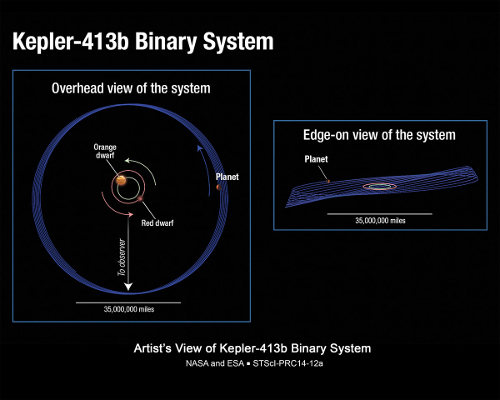Centauri Dreams
Imagining and Planning Interstellar Exploration
Kepler-413b: Wobbles of a Circumbinary World
It was always a good bet that we’d get plenty of surprises as data from Kepler began to come in, but the odd world known as Kepler-413b really does stand out. The transit method seems made to order for a certain regularity — Kepler looks at how the light from a given star dims when a planet passes in front of it as seen from Earth. Slight changes in these transits can help us detect other worlds in the system or, perhaps, help us make future discoveries of exomoons. But what happens when the transit is so erratic that both these scenarios can be ruled out?
Veselin Kostov and team have exactly that situation on their hands. According to Kostov (Space Telescope Science Institute and Johns Hopkins University), the data for Kepler-413b show, over a period of 1500 days, three transits in the first 180 days, followed by 800 days with no transits at all. Following that, the researchers noted five more transits in a row. And according to their analysis, the next transit is not going to happen until 2020.
Intriguing, no? The planet is a Neptune class world in a circumbinary 66-day orbit around a close eclipsing binary, K- and M-class dwarf stars that eclipse each other every 10 days. The system is 2300 light years out in the constellation Cygnus, and the image below depicts its complexities.
Image: This illustration shows the unusual orbit of planet Kepler-413b around a close pair of orange and red dwarf stars. The planet’s 66-day orbit is tilted 2.5 degrees with respect to the plane of the binary star’s orbit. The orbit of the planet wobbles around the central stars over 11 years, an effect called precession. This planet is also very unusual in that it can potentially precess wildly on its spin axis, much like a child’s top. The tilt of the spin axis of the planet can vary by as much as 30 degrees over 11 years, presumably leading to the rapid and erratic changes in seasons on the planet and any accompanying large moons. As Kepler views the system nearly edge on, sometimes the planet passes in front of the binary pair, and sometimes it does not. The next transit is not predicted to occur until 2020. This is due not only to the orbital wobble, but also to the small diameters of the stars and the fact that the orbital plane of the stars is not exactly edge-on to Kepler’s line of sight. (The vertical axis on the right panel is exaggerated by a factor of 10, for viewing purposes only.) Credit: NASA, ESA, and A. Feild (STScI).
The orbital plane of the stars is not edge-on, and as the caption notes, the planet’s orbit is titled 2.5 degrees with respect to the plane of the binary stars’ orbit. From Kepler’s vantage point, Kepler-413b’s orbit moves up and down continuously, accounting for why it often fails to transit its host stars. The wobble on the spin axis we see here is quite a contrast with the Earth, where the rotational precession amounts to 23.5 degrees over 26,000 years. The planet appears to be closer to its host stars than the inner edge of the habitable zone, with complex seasonal cycles and what the paper describes dryly as “interesting climate patterns.” Interesting indeed.
A key question now is whether there are other planets in this system that account for the tilt in Kepler-413b’s orbit, or whether a third star may be gravitationally bound to the system, thus exerting its own influence on the wandering world. That would give this unusual world the further distinction of being a circumbinary planet in a triple star system. We can also wonder whether there is a population of planets like this one whose transits we may be missing because we simply aren’t looking at their stars at the right time. Whatever the case, Kepler-413b gives us a useful circumbinary planet whose characteristics may prove helpful not only in terms of planet formation but questions of habitability outside of single-star planetary systems.
The paper is Kostov et al., “Kepler-413b: a slightly misaligned, Neptune-size transiting circumbinary planet,” accepted at the Astrophysical Journal (preprint).

Glimpsing Heat from Alien Technologies
An assistant professor of astronomy and astrophysics at Penn State, Jason Wright is well known to the Centauri Dreams community because of his continuing work on the search for extraterrestrial intelligence through detection of its waste heat rather than directed communication. The discipline widely known as Dysonian SETI is receiving more and more attention, and given Dr. Wright’s prominence in the field, I was delighted to receive the essay below, which offers background on the subject at large and an overview of his current project. Dr. Wright is a member of the Center for Exoplanets and Habitable Worlds and the Penn State Astrobiology Research Center (part of the NASA Astrobiology Institute), as well as being a member of the California Planet Survey consortium. His AstroWright blog is essential reading for anyone interested in SETI and the process of science at work. He also maintains the Exoplanet Orbit Database and Exoplanet Data Explorer at exoplanets.org.
by Jason T. Wright

My colleagues and I have begun the Glimpsing Heat from Alien Technologies (G-HAT) SETI program, which has been written about here on Centauri Dreams and in other places, like in this nice summary article. I describe some of the foundations of the search here on my blog, but I have written up this short primer for Centauri Dreams to collect much of what is there into a single post.
“Dysonian” SETI
The benefits of expanding beyond “communication” SETI have been discussed on Centauri Dreams before (for instance, here) and the argument was made forcefully by Bradbury, ?irkovi?, and Dvorsky here.
The essence of Dysonian SETI is that one is searching for the passive signs of an alien civilization, instead of the deliberate communication from them. Freeman Dyson’s original articulation of this principle remains the simplest: search for the energy that a civilization has used for its own purposes after it expels that energy. The disadvantage to this approach is that it may be difficult to distinguish such waste heat from natural sources, or it may be that advanced technologies do not emit large amount of waste heat.
Energy supply as sign of intelligent life
The term “energy supply” in the context of humanity refers to the total annual production of energy for human use. We generate this primarily through fossil fuel extraction and combustion, but it also includes energy generated through the collection of solar power.
Most species on Earth collect energy passively (through photosynthesis or collecting heat from the environment) or through consumption of other species. Intelligence is sometimes defined in terms of tool use, which involves the application of energy to objects to achieve some goal. More generally, we might use a “physicist’s” definition of intelligence to be the capacity of an organism or species to apply energy to its environment to collect additional resources for survival or other purposes. For instance, an intelligent species like humanity can build solar panels to heat its homes or burn gasoline to run farm equipment to harvest more food.
This is not to say that there cannot be other forms of intelligence, but this specific form of intelligence would allow a species to overcome resource limitations and grow. This intelligent application of energy can, in principle, be used to expand a population, and an energy supply, to fundamental physical limits (see for instance, my “TED-style” talk here.)
If this has ever happened — if an alien civilization has ever used its intelligence to create an energy supply that rivals the output of stars — then their waste heat would probably be detectable with today’s astronomical instrumentation.
“Waste heat” does not imply inefficiency or “waste”
Conservation of energy means that when one is done using energy for some purpose, one must expel it or else store it (though in the long run you can’t keep storing more and more energy). One might object that an arbitrarily advanced alien civilization could overcome this limitation, and it’s true that if alien civilizations inevitably violate conservation of energy, then our search will fail. But conservation of mass-energy is as fundamental a physical law as we have, and if we cannot assume that then we cannot have a meaningful, physics-based discussion about advanced civilizations at all. So it is reasonable from a physics perspective to search for the energy in waste heat, which should exist if alien civilizations do.
The term “waste heat” may seem to imply some sort of unnecessary inefficiency that an advanced civilization would be able to overcome. Not so. The confusion here is that when most people say or hear “energy” they are really thinking of “free energy” — the amount of work that can be done with a certain amount of energy.
For instance, when you drive to the supermarket the energy stored in the chemical bonds of your gasoline is converted to useful work that accelerates your car. When you are done with this energy — when you are ready to slow down at the supermarket parking lot — you press the brakes which dissipate the energy into the brake pads as heat, which then ultimately gets radiated away as mid-infrared radiation. This energy coming out of the brake pads now has a higher entropy than the energy that was in the gasoline— this means the energy has less “free energy” than before, so you can’t use that energy to make your car move again. In a regenerative braking system (like in electric or hybrid cars) your car attempts to collect this energy and put it back into the battery, but the second law of thermodynamics puts an upper limit on how efficiently this can be done — some of the free energy is lost with each braking cycle. Also, losses to friction with the ground and the air during your trip cannot be recovered efficiently.
So conservation of energy says that on the whole, an alien civilization that has a very large energy supply must expel as much energy as it collects or generates, and the second law of thermodynamics says that this expelled energy will have high entropy (very little free energy). We call this high-entropy expelled energy “waste heat”, even if the alien civilizations that uses it is very efficient and not at all “wasteful”. In fact, the more efficient the civilization is, the higher the entropy of the expelled energy, and the more it will have the properties of the sort we expect to see from waste heat.
One way around this limit is to emit the heat at a lower temperature. This is not possible on the surface of the Earth, where you cannot radiate heat away at a temperature lower than your surroundings (if you try, the opposite occurs — your surroundings heat up your apparatus). But in principle we could build huge, cold radiators in space that could operate as part of a heat pump, extracting more free energy from our waste heat to do more useful work. The difficulty here is that the radiators must be huge to get even a small benefit — the size of the radiators scales as the fourth power of the efficiency you gain, so improving the maximum theoretical efficiency of sunlight collection on Earth from 95% to 99.5% would involve building radiators with a surface area 10,000 times the size of that of the Earth, which hardly seems worth the effort. This means that we should expect alien waste heat from starlight to never be orders of magnitudes cooler than the surface of the Earth, because the engineering difficulties make the task pointless.
Detecting waste heat with telescopes
Waste heat at these temperatures will be apparent at mid-infrared wavelengths. The IRAS mission in the 1980’s surveyed the sky at these wavelengths, but did not have the sensitivity to detect most galaxies or stars because of the higher-than-expected background emission from dust in the Milky Way. The WISE satellite has much better resolution and sensitivity, and so does not suffer from this problem over most of the sky.
Most galaxies and many stars have “infrared excesses” — they give off much more mid-infrared emission than one would expect from stars alone. Today, we understand that this is because of astrophysical “dust” — a very fine smoke of organic molecules that is produced from the ashes of supernova explosions, in the atmospheres of giant stars, and in the disks of forming planetary systems. This dust glows brightly in mid-infrared wavelengths when it is illuminated by starlight — just as we expect alien civilizations to do. Now that we have sensitive mid-infrared surveys, distinguishing mid-infrared emission from dust and alien civilizations is the primary obstacle to detecting alien waste heat.
For now, the best we can do is to put upper limits on these civilizations. We can show, for instance, that there are no nearby galaxies filled with alien civilizations using all of their starlight — and we can do this for about 1,000,000 galaxies! We can also rule out civilizations using about 50% of the starlight — even the dustiest galaxies do not have so much dust that half of the starlight is being reprocessed by it. Going forward, we will continue to lower this limit down to around 20% (or even lower for some galaxies, such as ellipticals which host almost no dust).
Going any lower will require careful observation to see if the mid-infrared morphology or spectrum of a galaxy is characteristic of dust, or if it is anomalous in some way. Looking to individual stars in the Milky Way will actually be somewhat difficult, because many things that look like mid-infrared-bright stars are actually distant galaxies that are red for other reasons, dusty giant stars on the other side of the Galaxy, or young stars still forming planets in dusty disks. When the GAIA satellite finishes its survey, it will give us distances to most of the stars in the mid-infrared surveys. This will allow us to search for those that are mid-infrared bright, not giants, and not associated with star-forming regions filled with dusty young stars. If we find a star that is very mid-infrared bright, about the luminosity of the Sun, and not part of a stellar nursery, that will be a dead giveaway that something very strange is going on with that star.
A process of exclusion
Even if we find something anomalous, as scientists we must always reach for the naturalistic explanation first. Finding mid-infrared-anomalous objects is scientifically interesting in its own right and so a worthwhile scientific endeavor. If we can find no scientific explanation for an anomalous object, we must continue to search for new explanations and not immediately jump to the conclusion of “aliens,” lest we commit an “aliens of the gaps” fallacy. Only if we see an unambiguous sign of intelligence — if the Allen Telescope Array, for instance, detects complex and obviously meaningful radio signals from the object — will we be able to say SETI has succeeded. The G-HAT search, then, will have two implications for SETI: we will put an upper limit on the size of energy supplies being emitted as waste heat in nearby stars and Galaxies, and our best candidates will inform a target list for communications SETI efforts. In this way, the Dysonian and communications SETI approaches are strongly complementary.

Thoughts on Planetary Migration
Learning that liquid water may exist beneath the surface of more than a few Solar System objects naturally raises astrobiological questions. But as Caleb Scharf notes in Water Erupts Across the Solar System, a much larger issue is whether the kind of chemoautotrophic microbes we find on Earth (Scharf calls them ‘rock eaters’) could have evolved there in the first place. Habitats that may support an Earth microbe aren’t necessarily capable of originating their own forms of life, although the question is obviously going to propel much future study.
What strikes me about a number of recent stories in these pages is how much what we see in our own and other solar systems may be the result of planetary migration, which can affect those water-bearing objects. Ceres is a case in point, and it was my reason for bringing up Caleb Scharf’s always interesting blog in the first place. In Scharf’s post, he takes note of the fact that Ceres is a bit too close to the Sun for comfort given its composition. Let him tell it:
So now we come to Ceres, a 600-mile wide body orbiting the Sun in a gentle ellipse that takes it between about 2.55 astronomical units from the Sun to 2.98 in the course of its 1,680 day year. Compared to distant Europa or Enceladus it is in a much more precarious position when it comes to water. This is a zone where there can be sufficient solar heating to cause the ‘boil-off’, or sublimation, of solid ice into the vacuum of space.
A relevant point given the fact that data from the Herschel Space Telescope have revealed what seem to be water plumes coming from the surface of the dwarf planet. Scharf continues:
The current data seem to suggest that this boil-off, like that of a cometary nucleus, is the more likely culprit for Ceres’s watery outbursts – coinciding with its closest approaches to the Sun. However it’s still possible that there is an interior layer where liquid water could exist, warmed by a rocky core and insulated by a frozen crust and prone to cryovolcanic eruption.

Image: Hubble Space Telescope images of Ceres, taken in 2003-04 with a resolution of about 30 km. The nature of the bright spot is uncertain. Credit: NASA, ESA, J. Parker (Southwest Research Institute), P. Thomas (Cornell University), and L. McFadden (University of Maryland, College Park).
You can see the larger question behind all this, one relating to Ceres’ origins. We didn’t find reservoirs of water inside the smaller Vesta during the recent visit of the Dawn mission. Their orbits aren’t that dissimilar, and we’d like to know what factors gave Ceres the water that Dawn will be studying, among many other things, next year when it arrives. The assumption has to be that Ceres formed much further out from the Sun, which would imply a lot of movement in the early Solar System, likely triggered by migration of the giant outer planets. Maybe Dawn’s analysis of Ceres can give us some insights into the puzzle.
I hope so, because I agree with Scharf that “The eruption of water across the solar system is therefore not just a case of planetary indigestion, but another clue to the deeper origins and evolution of all that is around us.” As to why water implies a more distant origin, the ‘snow line’ of our Solar System is out around 5 AU, indicating a zone far enough from the Sun that water can condense into solid ice grains. We’re now learning, as we saw recently in Shaking Up a ‘Snow Globe’ Solar System, that main belt asteroids are far more diverse than we used to imagine, with the main belt representing only a small fraction of the initial asteroid population.
Migration of Circumbinary Planets

Planetary migration — the possibility of Jupiter closing to a Mars-like distance at some point in the early system — would have thoroughly mixed objects that formed in much different areas. How likely is such migration? We’re learning as we go, but recent work out of the University of Bristol extends the question interestingly to Kepler-34 (AB)b, a circumbinary planet that orbits not one but two stars. The work, published in Astrophysical Journal Letters, reports computer simulations showing that planets like these would have undergone migration.
Zoe Leinhardt (University of Bristol) is one of the researchers behind this work:
“Our simulations show that the circumbinary disk is a hostile environment even for large, gravitationally strong objects. Taking into account data on collisions as well as the physical growth rate of planets, we found that Kepler 34(AB)b would have struggled to grow where we find it now. Based on these conclusions for Kepler-34, it seems likely that all of the currently known circumbinary planets have also migrated significantly from their formation locations — with the possible exception of Kepler-47 (AB)c which is further away from the binary stars than any of the other circumbinary planets.”
Image: An artist’s conception of Kepler-34(AB)b which orbits a double-star system. Credit: David A. Aguilar, Harvard-Smithsonian Centre for Astrophysics.
Then, of course, we have the case of abundant ‘hot Jupiters,’ themselves thought to be the result of migration, forming well beyond the snow line but migrating through gravitational interactions to their present positions. Clearly issues of planetary migration are going to stay in the forefront of our attempt to understand how the planetary systems we observe evolved over time, and our own system gives us plenty to consider, as a watery Ceres reminds us.
The Kepler-34 (AB)b paper is Lines et al., “Forming Circumbinary Planets: N-body Simulations of Kepler-34,” Astrophysical Journal Letters, 2014, vol. 782, L11 (abstract / preprint).

Alpha Centauri: Dust and Its Significance
When I was growing up, Alpha Centauri was utterly dismissed as a possible location for planets. A binary system couldn’t possibly produce them, I read, and it was assumed that planets could only be found around single stars like our own Sun. How times have changed. Now we know of plenty of multiple star systems with planets — the number is over ten percent of all known exoplanets — and while many of these are widely spaced, we’ve nonetheless found a few in tight circumstances indeed. HD196885 (Gamma Cephei) is an example, where the separation between the two stars is on the order of 20 AU, much like Centauri A and B.
How planets form around such stars is an interesting issue because, as a new paper considering dust in the Alpha Centauri system explains, the standard core-accretion model runs into problems with environments as perturbed as these. We can see the results in existing observations: Radial velocity methods detect no planets more massive than 2.5 Jupiter masses inside 4 AU of Centauri A or B, and large regions seem, from theoretical models, to be a real challenge to planet formation, with an outer limit for the process perhaps in the 2 AU region.
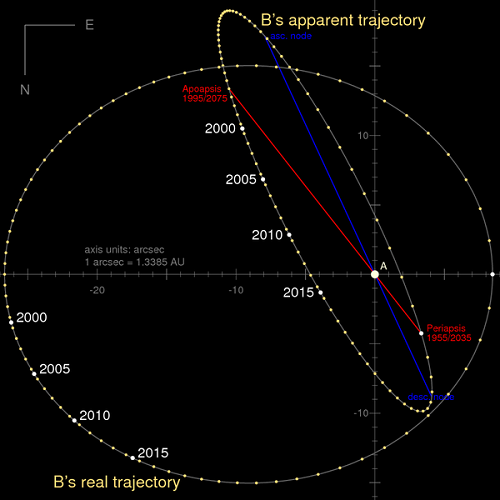
Image: Trajectory of Alpha Centauri B relative to A (fixed to the coordinate origin) as seen from the Earth (inclined ellipse) and face-on (horizontal ellipse). The orbit parameters are taken from Pourbaix et al. (2002). Credit: SiriusB/Wikimedia Commons.
What’s interesting about a new paper called “How dusty is α Centauri?” is that it gets into issues raised by the large number of planet-bearing stars known to show far-infrared emission from cool circumstellar dust. The authors, led by Joachim Wiegert (Onsala Space Observatory, Sweden), observed the Centauri stars to look for dust emissions there, presumably the results of collisions between objects up to planetesimal size. The team sought to understand the properties of the dust and to gauge the minimum temperature (Tmin) of the stellar chromospheres, a layer in the stars’ atmospheres that plays a role in how we determine the emission from cool dust in such systems.
The close-in Centauri stars, then, are templates that may help us find undetected dust disks around other stars. The team notes that it is::
…primarily concerned with the possible effects Tmin might have on the estimation of very low emission levels from exo-Edgeworth-Kuiper belt dust. The intensity of the stellar model photosphere beyond 20 to 40 µm is commonly estimated from the extrapolation of the spectral energy distribution (SED) into the Rayleigh-Jeans (RJ) regime at the effective temperature Teff. There is a potential risk that this procedure will overestimate actual local stellar emissions, which may be suppressed at the lower radiation temperatures. In those cases, where the SEDs are seemingly well fit by the RJ-extrapolations, the differences may in fact be due to emission from cold circumstellar dust (exo-Edgeworth-Kuiper belts) and, here, we wish to quantify the magnitude of such an effect.
As to Alpha Centauri itself, a slight infrared excess could be interpreted as dust emissions around both Centauri A and B. Disk modeling then produces the possibility of two circumstellar disks, the one around Centauri A being no larger than 2.78 ± 1.48 AU, while around Centauri B the limits are 2.52 ± 1.60 AU (the planet tentatively identified as Centauri Bb in 2012 is small enough and close enough to the star that it is inside the range of the authors’ disk models, and is thus ignored in their modelling). And while a circumbinary dust disk is possible at distances greater than 75 or so AU from the barycenter of the stars, no such disk was detected by these observations, and the authors note that other studies have made this scenario unlikely.
And this is interesting: “These size limits are reminiscent of the inner solar system, i.e., this opens the possibility for an asteroid belt-analogue for each star which forms dust discs through the grinding of asteroids and comets.” The results, displaying the possible disks and their snow lines, are shown in the figure below:
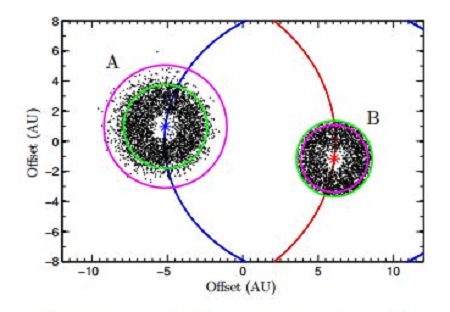
Image: Face-on circumstellar test-particle discs after ~ 103 periods shown with the stars close to periapsis. α Cen A is colour-coded blue (the left star and its orbit) and α Cen B is colour-coded red (the right star and its orbit). The green circles represent acrit around the stars and the magenta circles show estimates of their respective snow lines. Credit: Wiegert et al., taken from the paper.
We don’t yet know whether the excess at 24 µm the researchers found is a detection of warm dust or not — the paper describes the data as “marginal excesses” for both Centauri A and B, adding that “If due to circumstellar emission from dust discs, fractional luminosity and dust mass levels would be some 10 to 100 times those of the solar zodiacal cloud.” As we push deeper into the study of the nearest stars, we’ll use what we learn about dust emissions and their relation to stellar temperatures to study cool circumstellar disk possibilities around more distant targets.
The paper is Wiegert et al., “How dusty is α Centauri?” accepted at Astronomy & Astrophysics and available as a preprint. Thanks to Andy Tribick for the pointer to this one.

Habitability Around Ancient Stars
I see a lot to like about Abraham Loeb’s new paper “The Habitable Epoch of the Early Universe,” available as a preprint and now going through the submission process at Astrobiology. Not that it isn’t controversial, and for reasons that are patently obvious as soon as one digs into it. But the sheer chutzpah of postulating that microbial life might have started up no more than ten or fifteen million years after the Big Bang takes the breath away. This is a notion that extends life so far back that it defies our conventional models of how it formed.
Temperatures aren’t the problem, given that radiation in the early universe would have produced cozy conditions for a multi-million year window of time as what is now called the cosmic microwave background (CMB) continued to cool. The problem is that we have to get from hydrogen and the helium created by fusion in the Big Bang furnace to heavy elements that are usually explained by large stars seeding the cosmos with supernovae explosions. So we need to figure out whether or not such stars could have formed at this remarkably early epoch.
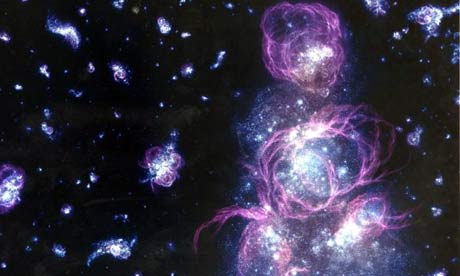
Image: An artist’s impression of how the very early universe might have looked as star formation began. Photograph: Adolf Schaller/AP.
Loeb argues that the first star-forming halos begin to collapse in this era. Certain density perturbations in this environment, rare but feasible, could have given birth to the stars we need, themselves the harbingers of the first rocky planets, which would have existed in a CMB radiation warm enough for liquid water to exist on their surface. Or as he puts it in the preprint:
Deviations from Gaussianity in the far (8.5?) tail of the probability distribution of initial density perturbations, could have led already at these redshifts to the birth of massive stars, whose heavy elements triggered the formation of rocky planets with liquid water on their surface. And even as the CMB continued to cool, the thermal gradients needed for life would still be created through geothermal energy as well as radioactive energies from unstable elements in the primordial supernovae. A blanket of molecular hydrogen could retain that warmth.
At a redshift of z ? 100, which Loeb regards as ‘the earliest cosmic epoch after which life was possible in our Universe,” we are dealing with a time when the universe was far denser than it is today, perhaps a million times as much, or approximately 1 hydrogen atom per cubic centimeter. This is typical of the average density of matter in galaxies, but imagine this density extended over the entire universe in that era. I should note that I’m drawing from Loeb here but also from Edward Harrison’s Cosmology: The Science of the Universe (Cambridge, 2000). When we go this far back, to a time 10 to 17 million years after the Big Bang, the cosmic microwave background has reached a temperature of 273-373 K (0-100 degrees Celsius).
The density issue is intriguing. A certain density of matter must exist within the universe to avoid a Big Crunch, with the entire cosmos falling back in on itself because of gravity, and recent work indicates that baryonic matter combined with still mysterious dark matter can account for 30 percent of that critical density. The balance is provided by a cosmological constant, an idea introduced by Einstein and later given punch by the discovery of cosmic acceleration in 1998.
It was back in 1987 that Stephen Weinberg argued that if the cosmological constant were just one order of magnitude larger than observed, stars would never form nor, obviously, would life. Loeb looks askance at that conclusion at the end of his paper, especially given the possibility that the amplitude of the initial density perturbations might have varied in different regions of the presumed multiverse. He makes the case that life could emerge with a cosmological constant that is (1 + z)3 ~ 106 bigger than observed. “The possibility of life starting when the average matter density was a million times bigger than it is today argues against the anthropic explanation for the low value of the cosmological constant.”
So we wind up with a new kind of habitable planet, one we are now considering for the first time. Yes, we can talk about liquid water on its surface, and we can throw in geothermal activity as well and radiogenic heating, but we might not need a star to nourish it given the help of the cosmic microwave background’s heat energy. As I say, it’s a fascinating concept, and one I don’t think I’ve run into in the most speculative science fiction. That situation should change soon enough as some talented practitioners of the trade get a close look at Loeb’s conclusions.

Starships: Sentient Habitats
Librarian and futurist Heath Rezabek has become a familiar figure on Centauri Dreams through his writings on existential risk and how our species might counter it through Vessels, installations conveying our planet’s biological and cultural identity. The Vessel concept is far-reaching, and if we build it on Earth, we would likely take it to the stars. But in what form, and with what purpose? Enter the lightsail starship mission Saudade 4, its crew — some of whom are humans by choice — nourished on the dreams of a continually growing archive. Heath’s chosen medium, the essay form morphing into fiction, conjures the journey star travelers may one day experience.
by Heath Rezabek
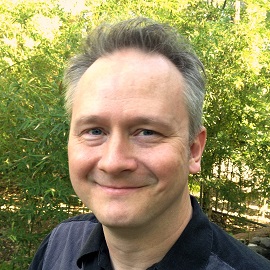
I’ve described The Vessel Project in four prior posts:
August 29, 2013 – Deep Time: The Nature of Existential Risk
October 3, 2013 – Visualizing Vessel
November 7, 2013 – Towards a Vessel Pattern Language
December 13, 2013 – Vessel: A Science Fiction Prototype
As I began preparing my paper on the Vessel project for the 2012 100YSS Symposium, one of the first things to occur to me was the potential crossover between the project’s goals and some of the functional requirements of a starship. While at heart a Vessel installation would be a comprehensive archive, the capacity of such a thing suggested so much more. I’ll explore these other facets through essay and fiction in coming installments.

Figure 1: Sailship – Adrian Mann (Used by Permission).
Providing a guiding intelligence for a starship would entail quite a lot. One role facilitated by a comprehensive archive would be that of ambient intelligence, a pervasive sentience throughout the craft. We can envision a starship as a layered technology, with data storage systems as one core element, surrounding habitat systems (however abstracted towards mere life support) as a surrounding space, and computational capabilities infused throughout like a nervous system.
Within this model, duties might include providing for the crew, whatever form that crew may take. We can envision miniaturized crew, artificial crew, biologically engineered crew, hibernating crew: all of these and more (unless completely inchoate or unconscious for the duration, as in a case where the crew is actually a cargo of nascent or embryonic humans) might make use of some kind of virtual environment in which to exercise their minds and their conscious needs.
In his paper “Transition from Niche Decision Support to Pervasive Cybernetics,” also presented at 100YSS 2012, Patrick Talbot detailed a framework for a cybernetic nervous system to be woven throughout a ship, as a self-aware knowledge base. It would need to be capable and flexible to handle the many functions needed of such a craft. The Artificial Intelligence Module (AIM) suggested by Talbot has some interesting qualities, including the design goal of deriving new patterns (“unknown unknowns”) through abstracting structured stories from its knowledge base. [1] Talbot’s model, along with a real-world creative writing exercise I’ve used in workshops, inspired aspects of Avatamsaka, the synthetic mind in this story fragment.
An archive that was comprehensive enough, and that included the means to sample from its contents and yield novel outputs not envisioned by its compilers, could conjure up whole worlds of the imagination for its dependent crew. This would of course yield a vast probability space for exploration, and also for assimilation of the contents of that archive over time.
It also lets us explore the Simulation Argument, [2] while providing one relatively benevolent answer to the question of why such comprehensive universe simulations might ever be run: To provide space and time for a passenger’s mind to roam. Thus, in addition to providing fertile ground on which to play out the unfolding of myriad possibilities in endless combinations, this fictional scenario also provides a counterpoint to cases in which a simulated universe would seem a cruelty. [3]
Here, I explore some of these themes, and touch on more to come.
[1] Talbot, P. “Transition from Niche Decision Support to Pervasive Cybernetics,” 100 Year Starship 2012 Symposium Conference Proceedings, 143-154 (2013).
[2] Bostrom, N. “The Simulation Argument: Are You Living in a Computer Simulation?” (http://www.simulation-argument.com). Accessed January 2014.
[3] Searle, R. “The Ethics of a Simulated Universe” (http://utopiaordystopia.com/2013/03/17/the-ethics-of-a-simulated-universe). Accessed January 2014.
Woven Light: Adamantine
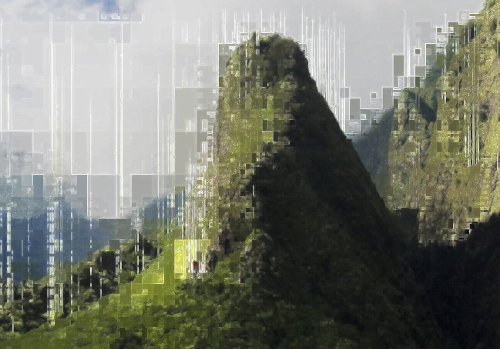
Figure 2: Mountain Shelter – Heath Rezabek
The sun was a golden haze, settling down upon this shambles by the sea. Near, inside a pilgrim’s shelter, Mentor Kaasura nodded at last light as it draped over hills and low roads, long since overgrown.
He had been seated there for much of the afternoon, sheltering from skittish rains. Before him, not far as a man might hike, lay the nameless, ruinous complex. Rusting generators brooded; breached coolant towers numbly gaped at the tumbling forest which scaled Iron Mountain to their west; behind their backs grey waves heaved and raked indifferently at the remains of its foundations.
None had lived here, or anywhere near these sleeping, vacant forms, for several generations; yet not far away, these timber shelters remained, small shadows crouching on the paths which faded into the hills. These leaning structures, maintained as they were by pilgrims of several sorts, each hosted a strange assortment of stowed and forgotten things.
Some of these were maps, through dreamlands now believed to be exposed here. Some were meditative texts, guiding the mindful reader towards countless branching worlds. And some were simply manuals on how to move through wilderness or doubt in a feral world.
But Mentor Kaasura had come in here clear of mind, free from fear, and had found this particular lean-to in the way he still recalled. Slowly stalking up the hillside, as the path around him crumbled into overgrowth and tussock, he had passed from shade to shade while lining up the old wayfinding beacons with ones more distant, until they drew a line upon which the distant Oiinu Arcology seemed to balance like a domed and lidded platter. And then, hardly needing to turn to enter the door, he sat to begin his meditations.
Clear and distant, a voice from before: ~If you go there, you’ll never return.~ His sister’s entreaty had seemed dismissive at the time, but hearing it again, through the lens of all their time before, he could see it had been a simple observation. Seasons returned; people returned. But time could not be rewound. Though things returned, they did so changed. He too would return, but the part of him that made the pilgrimage would recycle itself transformed. And so Kaasura sat.
He was here to ponder cycles. Though years were stretched long now, and little seemed to change from day to day, he knew from his own Mentor that there once had been a time when upheavals had seemed constant. The means to shape the world had unfolded and enfolded those who’d lived through that time, leading on to many things; even, yes, the crumbled generators now sinking into the valley below. He was here to ponder the means by which cycles stretched and snapped short.
But he was also in this place because he knew that here, the veil that braced the delving deeps was worn thin; and that this particular shelter, hugging the ragged mountain wall behind him, was a secret feint, a camouflaged diversion. He knew that he sat before an opening driven deep into the mountainside; he could feel a flow of slow sentience flooding the hut, streaming outwards from far behind him, and he shivered on his stump.
He could hear it just as well: a kind of sighing, or so he imagined. And so with eyes closed, to set imaginings aside, he began the traditional meditation on what still was called mortality; he saw himself standing out upon the road, then turning around to face the hut and him within it, standing firm as he gazed at the shelter, the brooding clouds above, the whispering shoots that crowded on all sides; and he saw himself clearly, seated there, facing out, eyes still shut.
And reaching down, as gently as he could, he took from his imagining hands a small and shimmering shard of knotted light, and bowed.
Stepping then beyond himself to enter this collapsing roof of a room, he faced the rear wall’s faded hanging, woven dense with interlacing. Beyond, he knew, lay the narrow channel through its iron-laden stone, walls dense with carven alcoves, splaying inwards into countless caverns and rivulets and grottos.
Mentor Kaasura paused, watching his outbreath. He committed to memory as much as he could of the tapestry’s patterned weave. Then blinking, his checkpoint saved, he stepped within.

Figure 3: Mountain Shelter (Detail) – Heath Rezabek
– – –
By the mid-21st century, Project Avatamsaka had yielded the most robust synthetic mind ever conceived. To that point, swarm AI had shown some promise, and conscious aggregate drone-clouds had several times surmounted emergency response situations which had left other systems dismayed. Newer and greater challenges had in time sparked the rising of new minds to meet them.
Avatamsaka was different. For this system had to lend spirit to a starship, with all the agency that implied. Design decisions had been made which only in hindsight could be seen as more than the sum of their parts.
Avatamsaka presented itself as a unitary consciousness, though not always as the same one. Depending on the approach of the crew member, Avatamsaka could appear as either female or male, and to varying degrees; its range of personalities would waver when first approached, until settling into a fairly stable persona while dealing with any one person. The logician would confront a transcendent algorithm. The vain would confront an inscrutable foil. And the dreamer would stand face to face with an imagination unending.
This kaleidoscopic impact was not entirely by design: the mind had been built to stay adaptive, and couldn’t have been otherwise, but the scale of adaptation was wholly unplanned and had come from Avatamsaka hirself.
Hir central core was not unique; there were copies and backups in various places, each a singular starting point for sentient aggregation. Like seeds, data cores could be planted within a digital mesh, and would bloom from within. These simple seeds had come from another project altogether, but as Project Avatamsaka had worked itself up to speed, it was seen that the one could easily benefit the other.
Each cubic lattice was called a Vessel cache, and their sizes varied greatly. Though they appeared quite the opposite, at simplest any one of these cores could be modeled as a black box. The outside world went in, and was drawn back out in fragments, glimpses, sketches, connections found between the elements emerging and new wholes reassembled on the fly.
In this way, it turned out to make an excellent foil for the pattern-finding at which Avatamsaka excelled.
The basic process of concept discovery and reconstruction was called pattern-sampling (or patterning), and could be experienced (in principle) as a kind of a game. Thus:
– Take your nearly-infinite deck of cards, with nearly-infinite things on them. This is your Vessel.
– Draw any number of samples. (Let’s say 5.)
– Identify just over half of them as most readily related or relatable. (Let’s say 3.)
– Discard the outliers. The remaining set is your glimpse of knowledge, your pattern-sample. Do with it what you will.

Figure 4: Pattern Sample – (public domain elements)
– – –
The ultimate aim was for Avatamsaka to use these sets to perform all the tasks and functions of a living lightsail starship. For a starship on an extended voyage, the tasks are many, and most of them are mission-critical as the time window for potential failure is so wide. But among these tasks, one of the less critical yet more complex was the augmentation of reflexive dreamworlds for the crew to experience during the voyage. “Crew” was an interesting term by the time the four ships called Saudade set sail. Certainly, what amounted to petri dishes outnumbered the astronauts. A minority of the crew was what we would have called human, and most of those people were people by choice.
——-
The Avaai had chosen to remain in human form, albeit an optimized one. If there had been a reason, these crew in theory could have navigated the actual physical spaceframe of Saudade IV. But there were also a slim few, who had chosen to be set into stasis entirely, as their bodies were barely augmented at all. These were the Ghemaai, and their choice would have been a tremendous burden had they not been an archival decision in the first place.
As things stood, they were no more a burden in their hibernating forms than the tanks of lastline biomass sampled from Earth’s biomes. And like their wild kin, even in their stasis, the Ghemaai could dream.
Or delve, as the term was. This state was unlike what we’d have recognized as dreaming, as much of the source material for these inner lives was drawn from the nearly-infinite stores of the Vessel cache by Avatamsaka, vented in pattern-samples to the nervous systems of all who slept, whether Avaai or Ghemaai.
When the nearly-infinite range of pattern-sampled impressions contained within a Vessel cache was blended with the nearly-infinite intuitive capacities of a sentient being, novel things happened. For the purposes of the crew of the Saudade IV, the most novel of these was the simple fact that through these means, generations of lives could be lived out in seeming, in complete immersion, flowing starwards through space.
One of the family lines enmeshed in this way bore the last name of Ramer. But only one of the lightsails in the first fleet bore those folk as crew or cargo, and as you may have guessed by now, this was Saudade IV. We can guess that there were at least four such craft in that fleet; but we can’t know if there were more, or where this leaves the other three.
~We can’t even know if there truly were three others to start with~ mused Odiah Ramer, when first he thought it through. But he was delving deep in the weave of the Avaai at the time, and before the lesson arcs had been patterned to guide fretful minds, this place was a disorienting place to be.
– – –
Somewhere in spacetime, Avatamsaka glides through the depth between stars, clad only in a lightsail named Saudade.
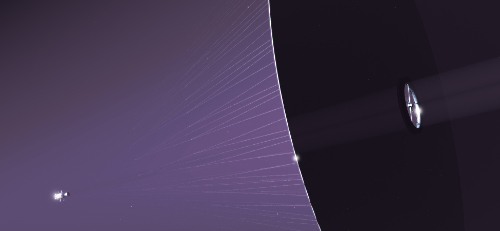
Figure 5: Sailship (Detail.) – Adrian Mann. (Used by Permission.)

